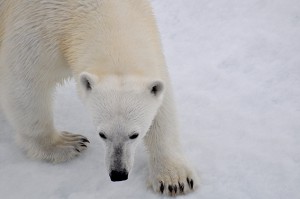 It is already August, we are since March on our way, time to clear some facts. Why a polar bear is never just a polar bear, and why a pixelbear rarely becomes a problembear, but sometimes creates problemguests, for example.
It is already August, we are since March on our way, time to clear some facts. Why a polar bear is never just a polar bear, and why a pixelbear rarely becomes a problembear, but sometimes creates problemguests, for example.
Who visits Arctic, wants to see polar bears. Clear. And he wants to see them in a way that enables him to take pictures he can show at home and post on Facebook, Instagram and all that stuff. Estimated 99 percent of arctic ship´s guests want that. To reach the goal of a good picture, the bear has to be visible in a way that the future comment to the picture will be: Wow! And not: Where?
That works best, when the bear is close. And clean. And on ice. Even better: Bloody. Feeding. Rolling. If sleeping, then cutely sleeping. At the same time, the guest does not want to get eaten by a bear. Thus, the bear should be close, but not dangerous, should not be sleeping, but somehow active.
Providing this bear picture show opportunity – this is what guides are doing. This is the reason why guides often have black rings around their eyes, not only due to lack of sleep, but also because of their staring through binoculars, while the rubber eye cuff of the binoculars somewhen fuse with the guides eye socket.
In the process of the search for the perfect bear, the guide encounters many other bears. First, there is the Pixelbear. The Pixelbear is laying somewhere far away as a yellow dot on a green slope. He is visible only with a huge crystal scope from Austria. Then there is the Twopixelbear, which flimmers around as a slightly bigger dot, and is visible already with binoculars. Fourpixelbears are visible without binocular, as long as they move on a green slope.
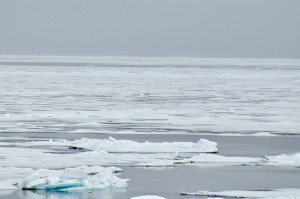 The difficulty with Pixelbears is often, that you cannot approach them, because they place themselves quite clumsily far inland. But the ship cannot drive on land, and also the zodiacs do not offer a better perspective. Pixelbears are sometimes useful. Guides have seen then finally at least something, which prooves they are able to find even things hardly visible. Unfortunately, guests with cigarette box sized cameras are not able to take pictures of the Pixelbears, on which you can detect more than a fluffy dot. Therefore the frustration potential of Pixelbears is medium.
The difficulty with Pixelbears is often, that you cannot approach them, because they place themselves quite clumsily far inland. But the ship cannot drive on land, and also the zodiacs do not offer a better perspective. Pixelbears are sometimes useful. Guides have seen then finally at least something, which prooves they are able to find even things hardly visible. Unfortunately, guests with cigarette box sized cameras are not able to take pictures of the Pixelbears, on which you can detect more than a fluffy dot. Therefore the frustration potential of Pixelbears is medium.
One- to Fourpixelbears can be summarized under Statisticbears. We can say then at the end of the voyage: We have seen 27 polar bears. That 25 out of it were Pixelbears usually does not interest neither the teller nor the listener. It sounds good.
Then there are bears close to the beach, of which you see the head or an ear or the butt. They would be close, but are not fully visible, thus they are Half Bears, a state which does not fulfill the parameters of a good picture. These bears even see the ship, but remain completely unimpressed. Bears are not stupid. They know: Ships, zodiacs, coloured animals – all not worth the effort. If he dedicates too much time to these kinds of things, he only burns too many arduously hunted sealblubbercalories. So they stay in their little hole, and latest after five minutes the guest is bored, usually, because it looked different in that Sir David Attenborough documentary. Understandable.
One guide this year said, media is nowadays so good, reality cannot keep up with it. Reality today can only disappoint. Well.
Then there are bears who see a ship and run away. These are the Fearbears. They only show the butts, and when you are lucky, there is at least no number on it, otherwise it is a Numberbear. If you are unlucky, there is a 73 to see, sprayed on the drugged bear´s butt by a scientist some years ago. The 73 was seen so often at the beginning of this season, that we believed already there is only the 73 left, and 25 ships have to share this one lonely bear. But the guest is in the end not really happy with a picture of a bear with a 73 on his butt, as it does not look entirely wild. Which is a point.
Is there a Halfbear laying in a hole directly at a landing site, thus a bear, that has no use for anything and who only destroys the landing (as you do not land beside a bear, of course) then you get another kind of bear: The Half Bear turns into a Disturbear. He only disturbs. The guest can neither take pictures nor hike, only take another coffee. Guides need to search for another landing site or a better bear straight away. Disturbears have therefore a higher potential for frustration than Pixelbears.
Then you also can miss a Disturbear and land right beside him. When the Disturbear then stands up after all guests have taken down their life vests and started to hike, the Disturbear can turn into a Helping Bear. This is a bear who looks impressive, is impressively close, snuffles impressively in our direction and then walks off. Then all guests and some guides stop breathing, and the guests stay from that moment on in the line and refrain from taking the 27th picture of the Svalbard Poppy, while all the others are already 50 meters further.
A Helping Bear can develop into a Scarebear, when he behaves like the Helping Bear, but then does not walk off. This you really really really do not want, and therefore you do not even want to write about it. And read.
Besides all these numerous bears, there is another one, very rare bear: the wonderful Ice Polar Bear. He is healthy, well-fed, clean. You meet him on the ice, and he is so curious, that he comes closer, so close that he snuffles around the bow, explores the ship from outside and under water. The wonderful Ice Polar Bear you can hear breathing, running on the crinkling snow, you look him in the eyes and even better, he looks into yours. You do not disturb him. With even more luck he catches a seal right beside the ship and starts feeding on it, while two ivory gulls sit beside him on the ice floe. That makes the pictures everybody wants. These are the moments that do not bore easily.
The wonderful ice Polar Bear causes uncontrolled endorphine happenings and watering eyes among guides and guests. The guide can finally plop the rubber eye cuff from his binoculars out of his eye socket, and the guest are able to take pictures of which the viewers says: Wow. Even with a 29 Euro camera.
An iceberg is then breaking from the guide´s heart, because he has finally found the cause for which the guest has spent thousands of Euros and come on the ship.
To see the wonderful Ice Polar Bear, a bear which is curious, who feeds on a seal, swims then in the water and rolls on an icefloe, is a great luck and an even bigger joy. It is a gift. It is rare. It is exactly what you see in Sir David Attenbouroughs documentaries.
And in the end, reality is still better than the movie.


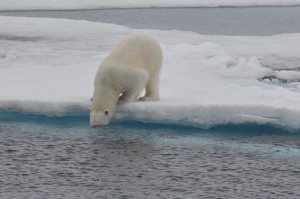
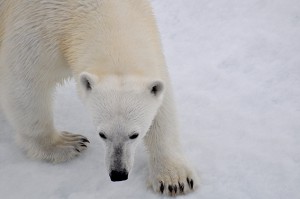
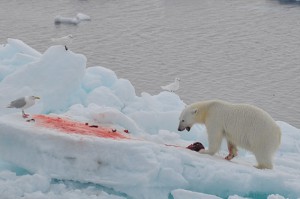
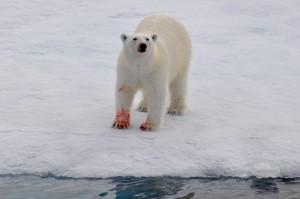
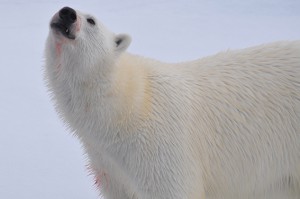
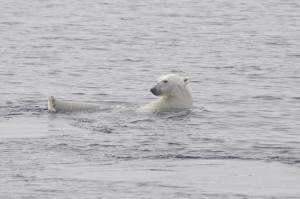
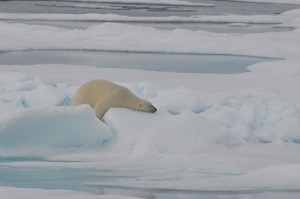
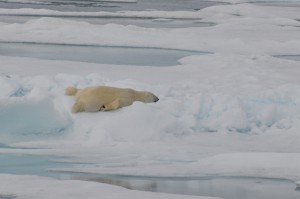
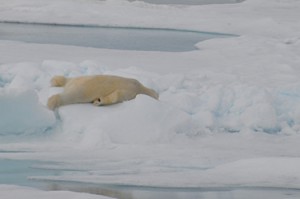
Very funny and well described. We had mostly pixel bears when we went to Franz Josefland last year but we did have the performance, on two occasions, of wonderful polar bears swimming right behind the ship. All in all we had a wonderful time.
Yes, that was a special voyage with really nice sightings!